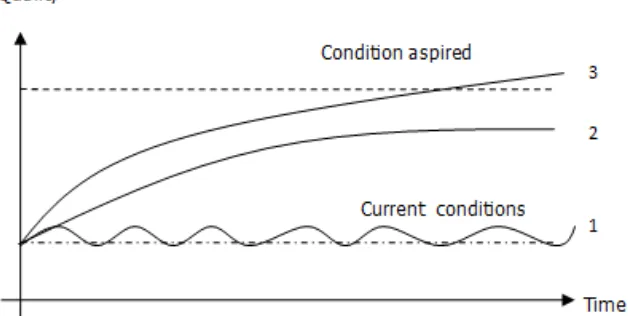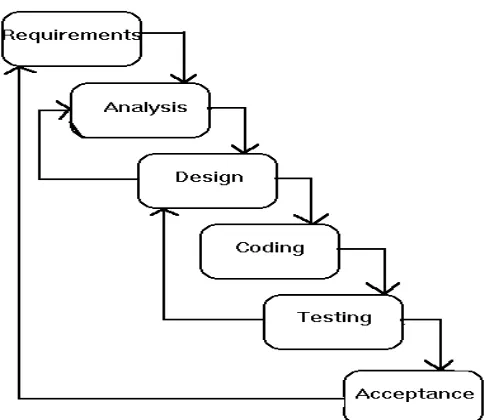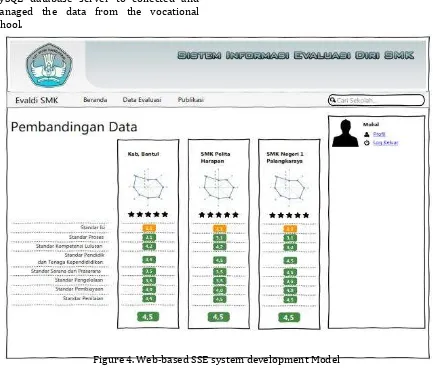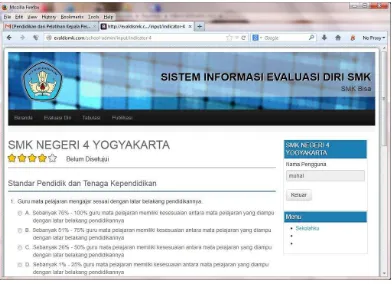166
WEB-BASED SCHOOL SELF-EVALUATIONFOR QUALITY IMPROVEMENT IN VOCATIONAL SCHOOL
Muhamad Ali 1), Lantip Diat Prasojo 2)
1) Electrical engineering Education Department, Faculty of Engineering 2) Educational Management Department, Faculty of Education
Yogyakarta State University Email : muhal@uny.ac.id
Abstract
The rapid development of science and technology resulted in increasing human needs that impact on increasing the level of competition in global workforce. Vocational schools as an educational institutions that were designed to produced graduates who were ready to worked need to maintained the quality of graduates continuously in order to competed in global marketplace. One attempts that must be done is to do a school self-evaluation to determine the condition and performances of schools. The high flurry of vocational school sometimes makes experiencing difficulties in school self-evaluation. it was required a school self-evaluation system that was easily used by vocational schools as a tool to improve the quality of education. Web-based self-evaluation system is one of solution to conduct an evaluation analysis easily and quickly. This article will discuss about the web-based vocational school self-evaluation as a tool to improve the quality of education. Then it also discusses how to designed and implemented web-based school self-evaluation in vocational education especially in Indonesia.
Keyword: web-based school self-evaluation, vocational education, quality improvement.
1. Introduction
Vocational education is an education of an applied personnel training mode and it is also an education of training skilled and applied talents for the social sectors (enterprises), so vocational education, which requires a lot of practice curriculum to train students’ operation capacity (Jhing Zhang, 2010). Vocational School (SMK) is one of the education level in Indonesia which has a strategic role in enhancing national economic growth. SMK is designed to produce graduates who are ready to work well in the world of business, industry and independent entrepreneurship. Quality improvement in vocational education was believed to produce professional candidates who are ready to use in accordance with their respective fields. Various efforts have been taken by the government to improve the quality of vocational schools through
various programs, one of which is a international level school.
The main problem in development of vocational school are self-evaluation system to measure profiles, the real condition associated with strengths, weaknesses, opportunities and threats were not optimum, so that vocational experience difficulties in making and developing excellent programs and activities. On the other hand, the government will also have difficulties in mapping the advantages of each existing of vocational school because of the lack of information that can be accessed at any time quickly, precisely and accurately. Vocational development tends to follow the trend of the moment is undergoing rapid development without good school self-evaluation analysis.
167
to play either of both roles, leaving manyschools unsupervised and unsupported. In response, countries have attempted to reform their inspection and/or have strengthened alternative evaluation tools. School self-evaluation was becoming more popular, especially among policy-makers, although its integration in schools encounters many challenges.
It is therefore necessary to design web-based information system for school self-evaluation that can be accessed for all people with a certain level to be able to integrate all the strengths, weaknesses, challenges and threats so that policy decisions can be made quickly and accurately.
2. School Self-Evaluation (SSE)
Evaluation is at the centre of almost all education quality improvement policies and strategies in most countries today. School Self-Evaluation (SSE) is a way of systematically looking at how teachers teach and how students learn and making decisions about what the school want to improve (Mathews, 2012). Self-evaluation is a process, not an event. It is the first, essential step in a cyclical process of bringing about change and improvement. It is based on professional reflection, challenge and support among practitioners.
School self-evaluation must be seen as a collaborative, reflective process of internal school review (bernard, 2005). During school self-evaluation the principal, deputy principal and teachers, under the direction of the board of management and the patron, and in consultation with parents and pupils, engage in reflective enquiry on the work of the school.
School self-evaluation is a continuous process that governed by the needs of the institution rather than the requirements of external bodies (Karl Smith, 2012).
Nevertheless, schools are accountable to their stakeholders; they need to be in a position to provide convincing evidence of their success and a clear plan of action to demonstrate how improvements will be made. The case study schools provide examples of how this can be done. They all have a positive and reflective ethos and are determined to improve.
Every organization should implement continuous quality improvement every time. It required a thorough evaluation periodically the existing resources, the process is run, the results obtained and other things related. Thus the significance of an organization can be measured and presumably there are things that are not in line with the vision of the organization can be directly known early on for further improvement (Ali, 2013). Further self-evaluation results known to the public is expected to increase community participation in improving the quality of education. Vocational school self-evaluation is an integral part of the process of development of the educational unit. The level of maturity of the institution can be traced from the results of self-evaluation during a certain period. This document will be very useful for the next leader, especially in improving the quality of education unit.
The process of self-evaluation is planned, executed and controlled properly can find the actual profile of an organization so that it can perform planning and appropriate action to achieve the aspired goals. The development organization that plans to use the self-evaluation that do not use self-evaluation can be shown in Figure 1 (PHK A3 Guide, 2006).
168
Figure 1.Ilustration of organization development3. Web Based Information Systems
Information system is the study of complementary networks of hardware and software that people and organizations use to collected, filtered, processed, created and distributed data (Jessup et al. 2008). Web-based information system displays many benefits of multimedia technology.
Using today's fast broadband connections, it is possible to stream sophisticated content to a computer anywhere in the world. This is an advantage for many people as the information can be received and read wherever and whenever it is convenient for them, which can be a crucial factor for a busy executive. A significant amount of interactive multimedia content is now delivered via the internet.
Information system can’t be separated from technology related information into a data processing and information distribution process data into information and the distribution of the data/information within the limits of space and time. Information Systems in order to operate optimally, it is necessary that information
technology has a proven good performance. The use of information technology as the basis of development of information systems would ensure the smooth flow of data and information and accurate data processing results. With the development of network systems both local and internet, makes the distribution of information will take place quickly and dynamically (Oetomo, 2002).
4. Web-based SSE System Development
169
Figure 2.Web-based SSE system development ModelNeeds analysis was done by collection of data and information through observation, discussion with parties related to vocational self-evaluation to determine user needs related to self-management of vocational evaluation. The focus needs analysis covering the processes that exist in the implementation of vocational self-evaluation, the user system that includes administrators, school supervisors, vocational school, Department of Education District / City / Province and Directorate of Vocational Training School.
The design of web-based school self-evaluation conducted based on vocational
needs analysis that includes system architecture design, database design, process design and display design. Database system was developed by MySQL server that can be used free.
170
5. Result and DiscussionWeb-based school self-evaluation system was implemented by PHP web programming language that can be accessed at http://evaldismk.com. This system used MySQL database server to collected and managed the data from the vocational school.
The server was implemented by Apache server that have high reliability in impementing web based system. The results of the preparation of the program code can be viewed on figured 4.
Figure 4.Web-based SSE system development Model
The database for the web-based school self-evaluation system was design and implemented by MySQL Server. The reasons for selecting MySQL server database based on consideration:
1) MySQL is an open source software, so are legally.
171
Figure 5.Data entry in SSESelf-evaluation in vocational was done by filling out a web-based school condition data in accordance with existing conditions. Self-evaluation includes 8 national education standards that include : 1 ) standard of contents, 2 ) standard of learning process, 3) standard of facilities and infrastructure, 4) standard of students and graduates competency, 5) standard of teachers and education’s staffs, 6 ) standard of management, 7) standard of financing, and 8) standard of assessment.
The evaluation process was done by form that provided in the web-based system to check the conditions faced each vocational school. The form is designed with a selection of existing conditions with weight rating in accordance with existing conditions. To be more convincing in filling the data, upload the necessary physical evidence required for each of the entered data. With this patterns, the process of self-evaluation can be done by the school quickly, precisely and accurately. Data Charging school self-evaluation carried out by an administrator appointed by the school concerned. In the charging process, the administrator was accompanied by a school inspector in charge to guide and
control the data that is loaded by the school. School inspectors will check the data that is loaded in accordance with the physical evidence so that it can be guaranteed that there entered data is the correct data. Data that has been filled by the school and has received approval from the supervisor will be sent to the central system then admin will verify the entry of data. The data has been verified by the admin center will then be processed and displayed a summary of the data in the form of a diagram . Furthermore, the data of this summary will be published in the system that can be accessed by everyone.
172
map the condition of schools in Indonesia .The Government may determine the strength of each school, 8 drawbacks associated with the implementation of national standards of education in Indonesia. With school self-evaluation data, government can make school mapping condition so that it can conduct training voational schools in Indonesia easily and quickly at any time at http://evaldismk.com by filling out a form that were provided.
b. The result of web-based self-evaluation in vocational school will be analyzed by the system and will be display in graphical chart that informed about condition on each standard and can be used as a basis for developing a work plan.
c. Government through the directorate of vocational training to perform the mapping for the development of quality improvement programs in vocational.
References
[1] ---. (2006) Panduan Penyusunan Proposal Program Hibah Kompetisi 2006 Program Peningkatan Efisiensi A-3. Jakarta: Direktorat Jenderal Pendidikan Tinggi Departemen Pendidikan Nasional.
[2] Anton De Grauwe and Jordan P. Naidoo, School evaluation for quality improvement , UNESCO: International Institute for Educational Planning, 2004
[3] Bernard, Hopkins, A new relationship with schools: improving performance through school self-evaluation , Department for ducation and Skills/Ofsted, March 2005 (hereafter DfES 2005). This document is available (2008). Information Systems Today Aidan Earl created the first Information System in Dublin, Ireland (3rd ed.). Pearson Publishing & Glossary p. 416.
[5] Jing Zhang, Jin Zhang, The integration of Information Technology and Practical Curriculum of Vocational Education , The 5th International Conference on Computer Science and Education Hefei, China, August, 24 – 27, 2010.
[6] Karl Smith (2012), The use of self-evaluation in teacher training, downloaded at internet address http://www.tttjournal.co.uk on March, 20, 2014.
[7] Muhamad Ali, Lantip, Pengembangan Sistem Evaluasi Diri SMK Berbasis Web untuk Mengembangkan SMK Unggulan berbasis Potensi Lokal . Laporan Penelitian Hibah Bersaing 2013, Lembaga Penelitian dan Pengabdian pada Masyarakat, Universitas Negeri Yogyakarta.
[8] Oetomo, B.S.D., 2002, Perencanaan & Pembangunan Sistem Informasi, Penerbit Andi, Yogyakarta.



